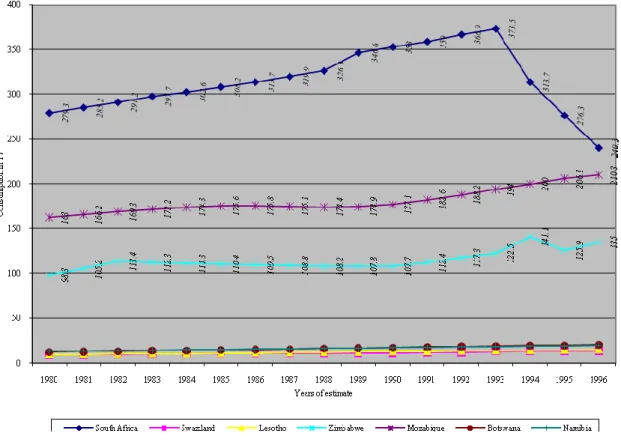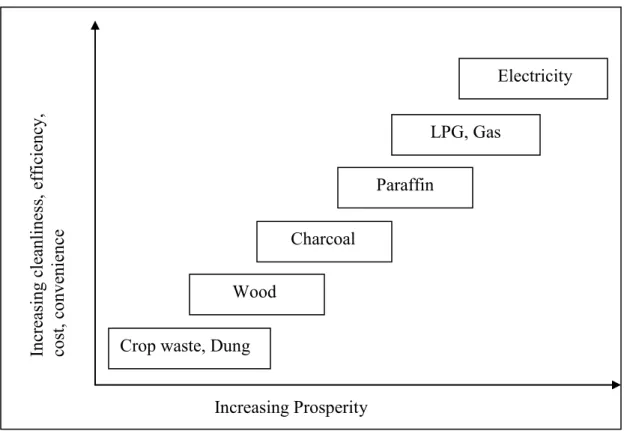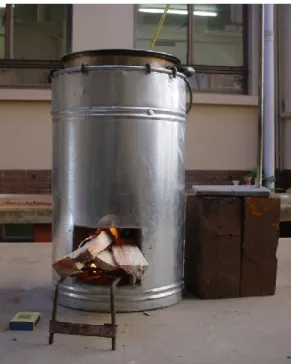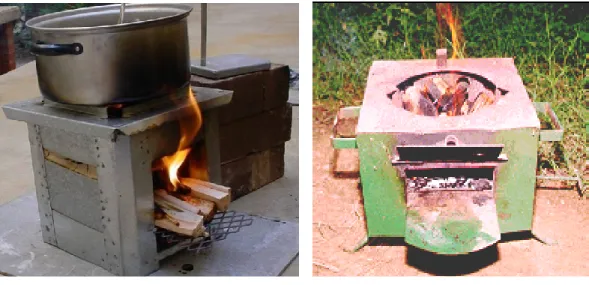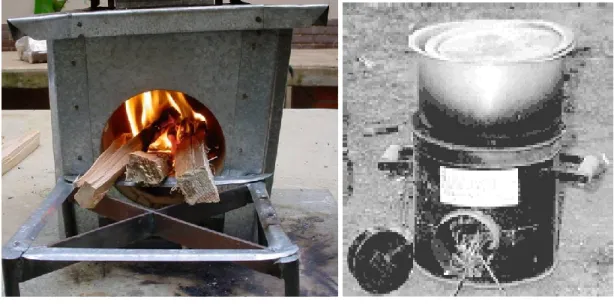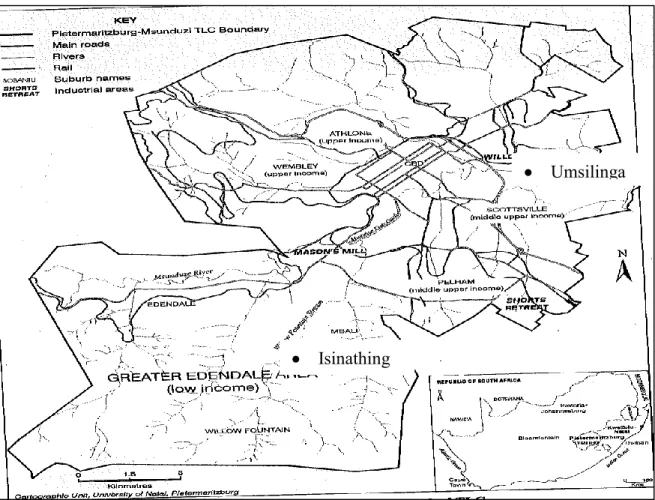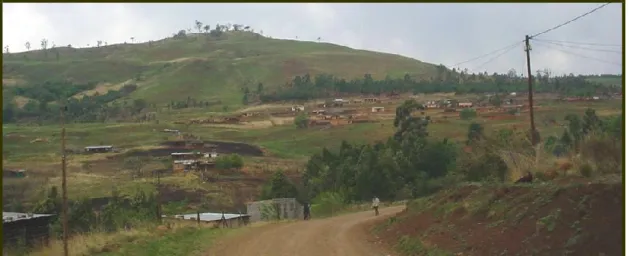Factors influencing consumers in choosing a specific energy technology to use, The efficiency of the improved wood stoves placed in 24 suburban households and observed for the specified period, and. She provided much of the original idea creation through discussion with her about the role of wood stoves in poor areas of KwaZulu-Natal.
Introduction
The high population densities in the urban areas cause cities to be centers of concentrated energy consumption. It therefore forces the poor to pay a higher price for their energy in the form of human time and labor.
Purpose of the research
The Research problem
The Research sub-problems
The open fire was used as a baseline because it was the most common technology used by households in the research area. The baseline study of fuel and appliances used and socio-economic characteristics of households in the two study areas was conducted using a structured questionnaire.
Assumptions
Demonstrate stoves in focus groups and place stoves in homes to evaluate their fit with user expectations in real cooking situations. The study also assumes that willingness to use stoves by 16 percent of participants in the baseline study, after demonstration of the stoves in focus groups and in homes where the stoves were placed for further observation would imply acceptable willingness of people to adopt the use of stoves.
Limits of the study
The study further assumes that energy requirements for lighting are not as severe as those for cooking and that much work on the former has already been done by other researchers (Ogunlade et al, 2003; Clark, undated). This is based on Roger's theory of diffusion (2003) where 16 percent was identified as early adoption success.
The theoretical framework
For example, large numbers of photovoltaic systems can be sold on a commercial basis, yet such technologies are known to be unaffordable even with subsidies to the poorest 25-50 percent of the suburban population in developing countries (Makino, 2003). ; Cecelski, 2000). The application of this concept to this study was useful as it guided the selection of the technology that would fit within the GHI triangle, thereby increasing the likelihood of acceptance of the improved wood stoves in the study areas.
Structure of the thesis
Introduction
Household biomass use in Africa
In addition, the initial investment in PV cost R per simple system, which most of the target users cannot afford. This is because most of the target users are facing declining income due to prevailing unemployment, poverty and HIV/AIDS (Makino, 2003; ITDG, 2002a).
The Peri-urban Household Energy Situation
- Acquisition and Consumption
- Household fuel choice
- Household fuel switching
- Urban poor and informal enterprises
Higher rates of evaporation of water from the pot in the improved stoves compared to the three-stone open fire mean higher output power of the stove. In Table 6.7 below, using each of the four improved wood stoves tested in the study would have annual fuel savings as follows, based on the following formula;.

Past examples of low income households energy interventions in South Africa .19
The off-grid electrification programme (Solar Home Systems)
This has resulted in a dichotomy in consumer satisfaction with SHS systems, especially among women who are traditionally responsible for collecting firewood for cooking (ERC 2004). Therefore, most SHS users used the system only as a temporary solution (ERC 2004).
The Free Basic Electricity (FBE) policy
Another problem is that the FBE allocation is allocated indiscriminately to all households, especially in most category A municipalities (with sufficient resources) (DME, 2003). This is because it is difficult to determine from a starting point who is poor and therefore eligible for the subsidy.
Household use of Paraffin
However, the widespread use of paraffin in South Africa is reportedly costing the country an estimated R 104 billion per year, which is poured into health and disaster relief through the regulation and enforcement of standards for both the resale of the fuel in prepackaged, child- resistant containers and enforcement of the minimum health and safety standards for the devices (Kruger, 2005). Placing the devices often by the door due to the harmful emissions or on the floor within easy reach of small children is also a contributing factor (Palmer Development Consulting, 2004).
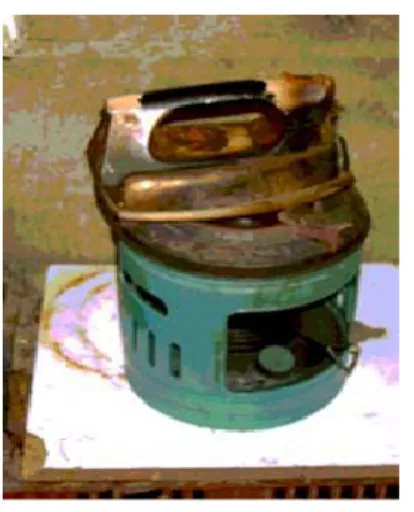
Renewable energy technologies in South Africa
However, a greater concentration of government efforts and international aid initiatives in renewable energy supply has been on home solar systems and specifically in rural areas in the formal sector. Financial, legal, regulatory and organizational barriers to SHS technologies implementation and market development.
Improved Cook Stoves
Previous work on improved cook stoves …
Despite their various benefits, ICS programs have not been a resounding success, especially in southern Africa. In Kenya, Uganda and Ethiopia, ICS programs enabled stove users to save money due to the reduced amount of wood used due to the stoves' improved efficiency.
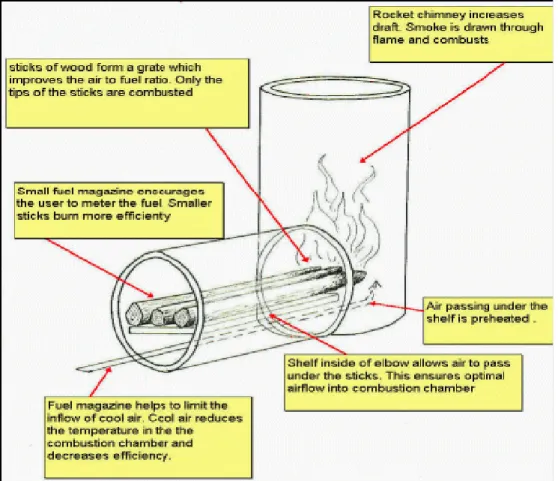
Improved cook Stoves used in the study
- The Vesto
- The Portable Household Rocket stove
- The Yamampera
- The Simunye Stove
- The Three Stone Open Fire
Like the Vesto, it is distributed through a commercial approach, purely on a cash basis, without any subsidies (ProBEC, 2007). It is intended to be distributed in both urban and rural areas through government agencies, NGOs, private industry, etc., through a commercial approach.
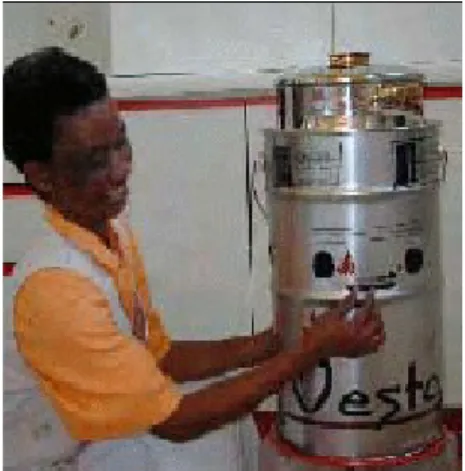
Conclusion
Modern, improved renewable energy technologies are already the government's priority, but they still remain unavailable and unaffordable to the majority of targeted poor urban users. While the lack of electricity remains one of the main barriers to addressing socio-economic issues that limit sustainable livelihoods, it is important not to ignore issues such as energy availability, affordability, sustainability and security in the context of the nature and the standards of the housing used by the population. urban poor.
Introduction
Geographic location and climatic conditions
The area is characterized by a semi-arid African savannah dominated by grassland that was planted with eucalyptus trees by the white owners during apartheid. The area is mainly surrounded by the sugar cane plantations with scattered eucalyptus plantations belonging to the sugar cane plantations.
Infrastructure
It is covered with brown soil, which has limited drainage both at higher elevations and on steeper slopes. Unlike Isinathing, Umsilinga has no running water and the women walk about 5 kilometers to the water pump.
History of the study area
As a result, most of the population commutes daily to the central business district (CBD) and surrounding industries, which is about 10 km from Umsilinga and 12 km from Isnathing (personal communication with Thandi Dlomo, July 2006). This phenomenon has largely contributed to the development of informal settlements in the two study areas with mostly poor housing infrastructure, which often fall victim to accidental fires caused by inefficient panda paraffin stoves (Figure 3.4).
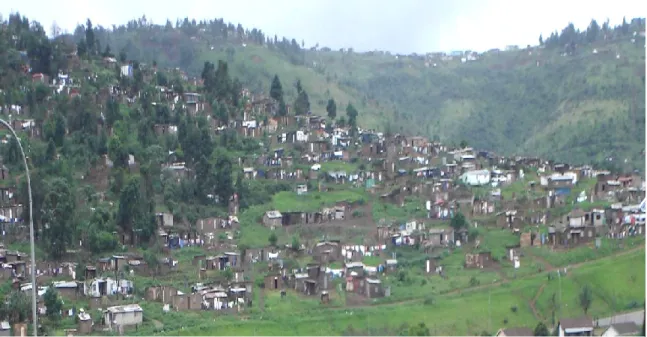
The Human Settlement
Population
These areas should be given priority focus within the special development programme, while attention will be paid to facilitating an integrated planning and development process for the entire area as part of the statutory Integrated Development Plan (IDP) for the city.
Settlement and Household Characteristics
44 Table 3.2 Dwelling units and population estimates by income levels in VMV-TLC 1998 (Source: Integrated Planning Service (PTY) LTD, 1998).
Unemployment
Access to Energy
Additionally, collected fuelwood accounts for a larger proportion of the total fuelwood used in the area, although some households do purchase from local vendors. This often places excessive demands on access to fuelwood and establishes a strong correlation between energy shortages and poverty where the existing energy sources (fuelwood) are heavily relied upon and consequently weakened due to demand.
Conclusion
48 However, the relative availability of firewood in these areas must be taken into account in wider urban energy scenarios and interventions in order to efficiently and sustainably utilize limited resources. This would help in solving the current problems of poverty, unemployment, unequal distribution of resources, poor social services and facilities, and environmental degradation and deforestation in the study area.
Introduction
The improved wood-burning stoves would be more valuable to the 65 percent of the sample population in the study area who currently rely on firewood for cooking especially difficult-to-prepare foods, with 80 percent of these households cooking on the three-stone open fire (Chapter 5 of this thesis). 104 The average household income in the income groups to which the household using the improved stoves belongs.
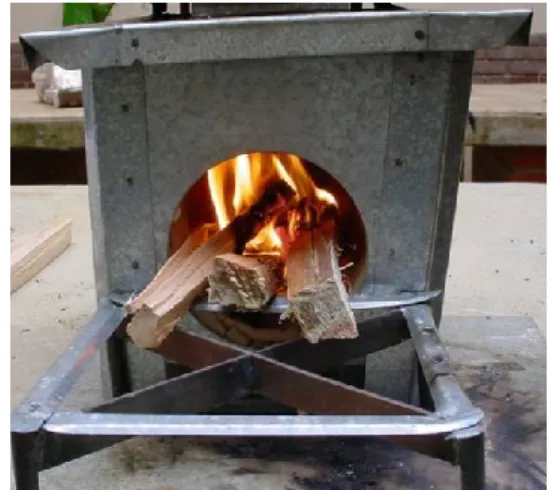
Summary of the Study design
Population and sample selection
The Research Sample
St: Savings in fuel costs over the lifetime of the stove Ct: Cost of the stove. The study has shown that the use of the four improved wood stoves used in the study would help meet the pent-up energy demand in peri-urban and informal urban areas.
The Field work
Tools used in the study
The second tool was a baseline survey questionnaire on fuels and appliances used by households in the study areas as well as general socio-economic background of the households participating in the survey. The above two tools were supplemented by a questionnaire administered to the selected households where the stoves were located later in the study to gauge user opinion on the performance, efficiency and other socio-economic benefits of the stoves compared to other existing and used fuels and appliances. for the same purpose.
The comparative efficiency performance test
Pre-test procedure
Fuel and water were procured in advance to ensure an adequate supply of clean water and a considerable amount of firewood. Care was taken not to let the thermometer touch the metal bottom of the pot to prevent cracking.
Water Boiling Test
As seen earlier (chapter 2), these micro-enterprises are a crucial factor in the economic empowerment of the urban poor. 120 R&D for stoves to increase the efficiency of improved wood stoves, for example doubling the current efficiency level of the four stoves used in the study;.
Water simmering test
Household baseline survey
Survey questionnaire organisation
After the pre-test, minor adjustments were made to the questionnaire in terms of wording before the actual survey was conducted. In all these questions respondents were prominent members of the households such as household heads or the oldest in the household.
Baseline survey organization and administration
The findings of the efficiency test results (Chapter 5.2) summarized in Table 6.1 below indicate that the improved wood stoves performed better in burning wood and heat output to the pot than the three stone open fire. Furthermore, the performance of the three stone open fire was less effective compared to all the improved wood stoves used in the tests due to the lower burning temperatures it achieved and the time it took to reach boiling point temperatures.
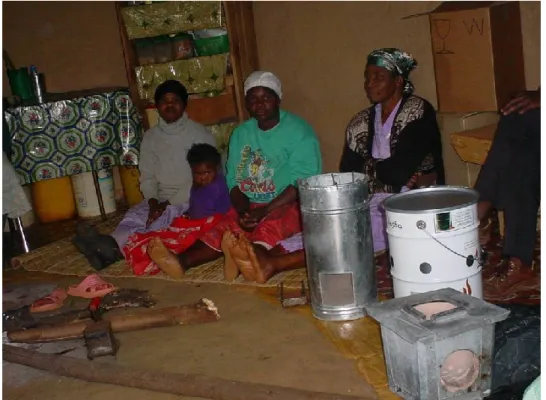
Stoves demonstration
Focus group discussions
Selection of focus groups
In each study area, the researcher was assigned a contact person from the local development group who planned the discussions, organized a structure, and in some cases, identified individuals to participate in the research discussion groups as moderators. The groups were selected by the researcher in consultation with the leadership of the local development committee in the study area because of the diversity of their experience with such groups in both areas.
The research team
Eight focus group discussions (FGDs) were held in the two study areas (Isnathing and Umsilinga) during the normal weekly meeting times of already existing clubs and societies. All the respondents were heads of households or wives, and in their absence, the one who was responsible for cooking and deciding on the type of stove participated in the discussion.
How the discussions were conducted
The household performance test (HPT)
Household fuel consumption measurement
The second phase of the qualitative survey was conducted for two weeks from the time the improved stoves were placed in the homes. However, households that participated in the HPT were each offered a free stove and some cash at the end of the tests as a token for the work done during the Household Performance Test (HPT).
Data treatment and analysis
Introduction
The comparative stove efficiency performance test
Water boiling test
- Time taken to boil water
- Power output
- Time saving
- Wood used and saved
The amount of water evaporated from the pot on each stove and the three stones open fire. It also shows the time saved at each stove compared to the three stone open fire.

Simmering test
- Time taken and frequency of attention to the fire
- Power output
- Combustion efficiency
The poor combustion efficiency of the three-stone open fire was largely due to some of the heat of the three-stone open fire being conducted away from the bottom of the pot even with very little wind. 74 This poor burning efficiency of firewood in the three-stone open fire means that the technology needs much more firewood to produce matching results from the improved stoves.
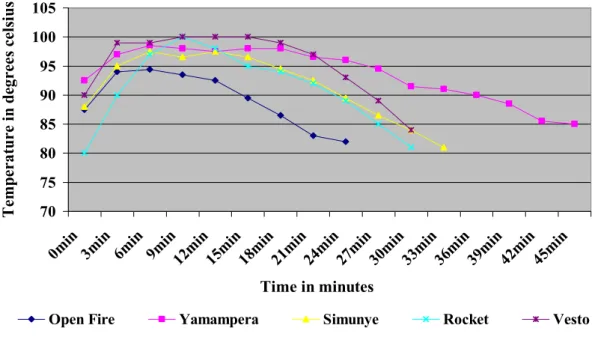
General descriptive data of those interviewed during baseline survey
- Household size
- Gender and education of household heads
- Employment status, income and expenditure
- Households asset ownership
- Types of fuels used
- Households’ uses of available fuels
- Households perception of the fuels used
- Types of food cooked and fuels used
- Household size and type of fuel used
- Type of fuel used and expenditure
- Income, gender of household head and fuel use
- Age of household head and type of fuel used
- Education of household head and type of fuel used
- Households perceptions of improved wood stoves
The use of a mixture of paraffin and fuel as well as fuel wood only increased with family size up to 9 members, after which it decreased drastically (Figure 5.12). This suggested that paraffin and fuelwood were perceived as expensive for the smallest and largest households and affordable for the average household size.

Consumer perception of improved wood stoves
Focus group discussions after demonstration
The economic value of the net benefit for the household is determined when the net benefit is compared with various items in the household's budget. As such, it is concluded that the use of the four stoves used in this study will have major socio-economic and environmental benefits for the peri-urban poor.
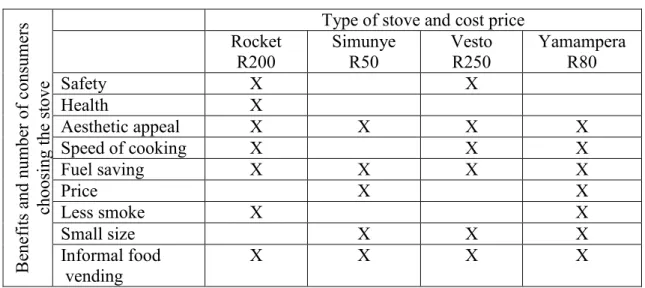
Focus group discussions after stoves placement in homes
Improved wood stoves use
Speed of cooking, fuel and cost saving
More than half of participating households were satisfied with the cooking speed of improved stoves and the ease of cleaning and maintenance. Nearly all participants (88 percent) indicated that the speed of the improved stoves overall definitely reduced fuelwood consumption and household energy consumption.
Conclusion
Radiant heat transfer from the fire to the pot by keeping the pot as close to the fire as possible. Convection from the fire to the pot by transferring as much hot gases as possible to the pot and reducing drafts.
Introduction
92 This chapter discusses in detail the socio-economic performance of using the four improved wood stoves used in the study compared to three-stone open fires and to some extent panda paraffin stoves and LPG burners as alternative technologies.
Multiple fuel use
As depicted earlier in this chapter, the economic value of each of the four improved wood stoves used in the study for household well-being will be determined when the net benefit is compared to other items on which the household spends its income. St: Savings in expenses for fuelwood during the life of the stove Kt: Cost of stove.
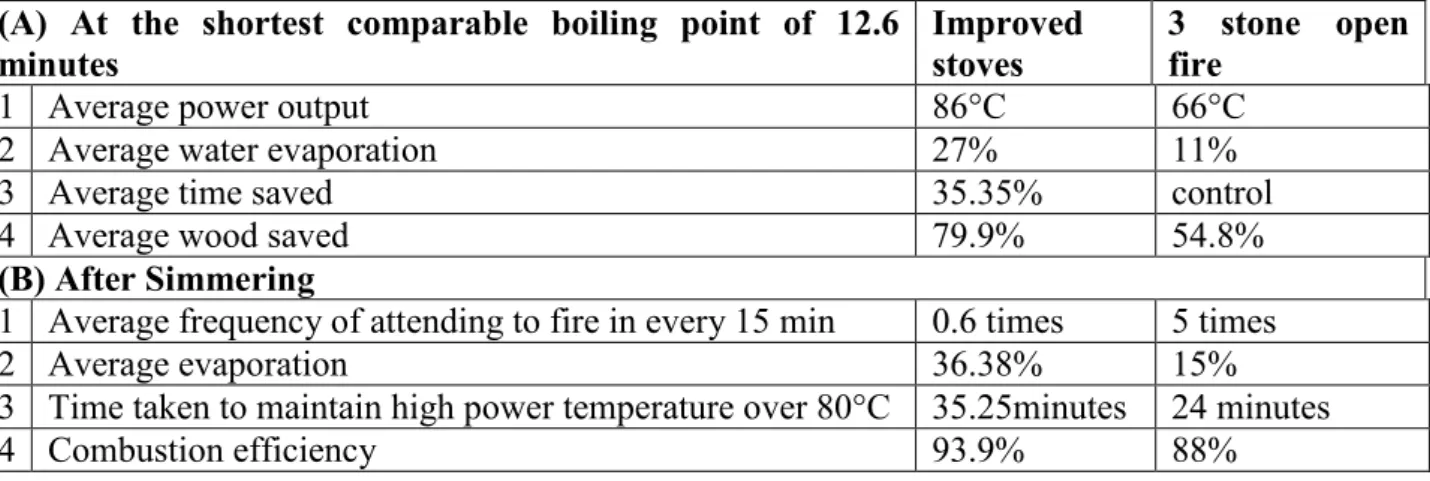
Performance efficiency
Efficiency of the stoves versus that of the three stone open fire
Time saving
The similarity of the findings in this study with those of Barnes (1993) in Niamey and Niger, where the use of improved wood-burning stoves resulted in 42.8 percent wood savings over the years. However, the return does not provide any indication of the relative value of the net benefit to the household.

Economic quantification of fuel saving benefits
The payback period
The payback period of the improved wood stove in this respect is the length of time in days, months or years that the household will take to recoup the initial investment cost. Additionally, if the improved wood stove does not pay for itself within this period of use, the fuel wood savings do not represent an economic benefit to the household.
Net benefit
Although all four improved stoves are likely to pay for themselves within their lifetime (i.e. generate benefits that equal or exceed the required investment), households are likely to benefit more from using the Yamampera due to the meaningful benefits , which could be realized sooner rather than later. This would be the case because the net benefits of using these improved stoves exceed the costs associated with their purchase and use.
Rate of return
Nt: Net benefit of the improved furnace over its lifetime Ct: Cost of the furnace over its lifetime. This means that the net benefit of using these stoves over their lifetime should be between 8 and 80 times the total cost of purchasing and using the stove.
Ratio of net benefit to other household budget items
When analyzed in the context of the household economy, the net benefit ratio provides additional information. This is different from the improved stoves used in the study, which have a high net benefit as a percentage of related budget items, as shown in Table 6.4 below.

Total annual costs of alternative fuel for cooking
Because of this, the benefits of using these improved stoves would be quite substantial in the family's living portfolio. Therefore, Paraffin and LPG are unlikely to be viable alternatives to fuelwood as cooking energy in poor peri-urban households in the near future.
Net present value
In this analysis, the cost of using paraffin and liquefied petroleum gas (LPG) for cooking is quantified because some households in the study area use these fuels. This will help households determine whether paraffin and LPG can provide a viable alternative to fuelwood for their cooking purposes.
Summary of economic benefits
However, the net present values of each of the stoves are much lower than the undiscounted ratios (the net benefit ratio). Net present value better estimates the net benefit or incentive to the household as it takes into account when the costs and benefits of an investment accrue.
Health benefits
Based on the above economic ratios, the net present value of using the improved wood stoves is higher than the paraffin stove and LPG burner and compares favorably with the use of paraffin stove and gas burner. Less frequent attention to the fire when cooking on the improved wood stoves reduces exposure by the users to even fewer emissions from the improved wood stove.
Role of Women
The introduction of improved wood stoves would also have the added benefit of creating potential employment for local housewives. 42 percent of respondents (all women) felt they would participate in improved wood stoves as a street food processing and selling business, thus creating informal jobs for women and addressing the unemployment rate of 31 percent.
Environmental benefits
For example, in Umsilinga, fuel wood consumption increased regardless of income increases due to a restriction of alternative fuels. This is in accordance with the study conducted in Niamey in 1987 (Dechambre, 1988) where the daily per capita fuel wood.

Conclusion
Conversely, households with a large number of children had a higher percentage of wood consumption per capita (78.9) compared to 46 percent of households with a large number of men (Chapter 5.3.12). The finding that charcoal remains the main resource for the urban poor also assumes that charcoal and firewood are always available at the same time and are fully substitutable substitutes.
Introduction
Conclusions of the study
Effective mass expansion of stoves would be of great importance to protect overburdened biomass resources in the study area and bring sustainability of energy supply among the suburban poor. A reliable and efficient network of these improved wood-burning stoves needs to be developed, preferably in the private sector, to provide information and technical services and supply the necessary materials needed to acquire the technology.
Contribution of the study
Distinguishing between short- and long-term options
Distributing all four types of wood-burning stoves used in the study and addressing bottlenecks affecting the spread of these wood-burning stoves could be considered as a short-term option. Although encouraging local production of all four stoves at different business levels can be seen as a long-term option.
Recommendations for further research
Dynamic analysis
Optimal stove efficiency, threshold rate of spread and forest
Economy-wide analysis
Electricity Basic Services Support Tariff (Free Basic Electricity): Policy for the Republic of South Africa. DME, Pretoria. DME) Department of Minerals and Energy, 2002. South Africa's poorest citizens lose out under efforts to recover service costs for water and power.
Improved wood stoves and the three stone open fire comparative
List and signatures of participants for voluntary participation in the
In your opinion, it is the cost of the form of energy you are currently using for cooking;. Based on the stoves demonstrated today, which of these would you prefer to use in your home?.
Fuelwood usage and benefits
